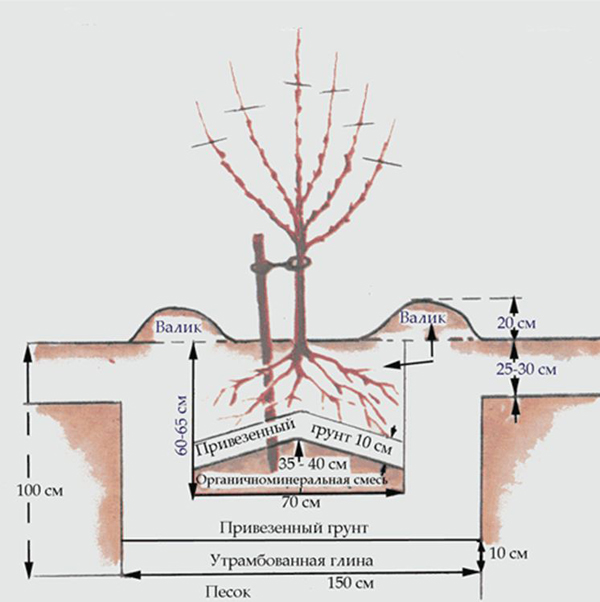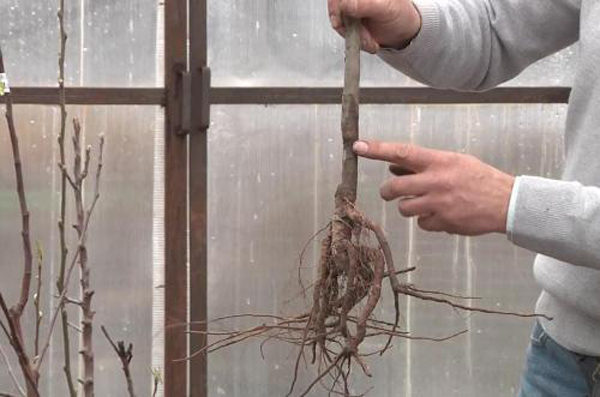Features of planting apple seedlings
If your next plans are related to planting an apple orchard and you dream that it will grow healthy and please you with generous fruiting, then this article is for you. In it you will learn how to plant an apple tree seedling in your garden plot.
Content
Sapling selection
First of all, pay attention to the apple variety. It is advisable to choose the one that can easily take root and grow in your climatic conditions.
According to the ripening time, the following three groups of varieties are distinguished:
- summer. The period of active fruiting occurs in August. Fruits are usually stored for a week. Representatives: Medunitsa, White filling.
- autumn. Fruit ripening - in the first days of September. Stored for no more than a month. Popular representatives are Korean, Melba, Cinnamon striped.
- winter. They bear fruit in the last days of September and keep well for six months. Such seedlings are perfect for those who live in regions with hot summers and warm autumn. Representatives - Bogatyr, Antonovka, Welsey.
The choice of the place of purchase should also be taken seriously. It is better to purchase from those garden organizations or nurseries that are located in your area. You can choose several companies at once, study their reputation, customer reviews, and only then stop your choice on someone specifically.
Next, you need to decide on the type of plant, depending on the rootstock. Based on this, there are:
- vigorous apple trees. Their height does not exceed 8 meters, and the root system has rather deep roots. Suitable for land plots where groundwater runs at a depth of more than 3 meters;
- semi-dwarf. The height of the trees is up to 5 meters. They will be an excellent choice for a summer cottage where groundwater is located no deeper than 2.5 meters;
- dwarf. The height of such varieties does not exceed 2.5 meters. They will be the best option for owners of sites with groundwater flowing near the surface at a depth of up to 1.5 meters.
When buying young animals, it is advisable to focus on the groundwater level in the place where this tree will grow. After all, if the depth of the flow is lower than the root system of the tree can reach, it will be frail, often hurt and rarely bear fruit.
Carefully and scrupulously inspect each sample, paying attention to even small defects, because there are no trifles in this matter.
Remember that the appropriate age for planting is 1.5-2 years. The younger it is, the faster and better it will take root in your garden and the shorter the period of its adaptation will be.... You can determine the age yourself. If the tree does not have developed branches, you get a one-year-old. While the two-year-old already has several additional branches located at an angle of 45 to 90 degrees.
Examine carefully the condition of the stem and root system of the plant. There should be no damage. The stem under the bark should be a healthy, light green color. This can be easily verified by gently picking up the bark with your fingernail. The roots should be elastic and moist, and never brittle or rotten. It is not recommended to purchase large samples, as a rule, in most cases, their roots are significantly damaged. Such an apple tree takes root hard and often gets sick. Caring for her requires considerable effort.
Purchased seedlings should be stored in a cool place, previously wrapped in plastic with ventilation holes made.
How to choose apple seedlings (video)
This video will show you how to choose the right apple tree seedlings.
Planting stages
Be aware that planting apple seedlings is not recommended if the soil on the site is swampy, stony or gravel. It is necessary that the soil easily absorbs water and air. The passage of groundwater is also important. The optimal flow depth will be no deeper than 200 centimeters. When planning to plant an apple orchard, please note that it is necessary to leave a distance of at least 3 meters between the trees, and all 6 meters between the rows.
Planting consists of two stages: preparation of the "house" and placement in the pit. Let's consider in detail how to properly prepare for these stages.
It is advisable to create a hole for the seedling a month before planting (in early spring). You should dig a rounded depression in a place you have chosen in advance, up to 70 centimeters deep, and no more than 100 centimeters in diameter. The pit walls should be steep. Set aside the top fertile layer from the rest of the soil - this land will still come in handy. Drive a stake with a diameter of at least 5 cm into the center of the pit, and the length should be such that it protrudes freely from the pit by at least 40 cm. So that the lower part of the wooden stake, immersed in the ground, does not rot, it should be burned in advance.
Mix the deposited fertile layer with peat, humus, compost and add the necessary organic fertilizers. If the soil in your area is clay, then you can add some more sand. The resulting fertile mixture must be filled up to the very top, so that a small mound is located above the surface. Such a hill is necessary so that after the soil has settled, the tree does not end up in the funnel. Since the pit is prepared in advance, a month in advance, it is possible to see in advance how much the earth will settle. The soil that remains can be used to form a small shaft around the pit.
Preparing for landing
If you have a predominantly clay soil on your site, you need to dig a hole deeper than 70 centimeters. A layer of stones or gravel should be laid on its bottom - this will be drainage. It will provide the plant's root system with a supply of air and additional nutrition for several years. If the drainage layer is not done, then the pit should be wide, up to 4 meters deep. This depth contributes to the fact that in the fall, during heavy rains, the water will not stagnate in the pit and will not cause disturbances in the formation of the root system.
In the event that you have sandy soil, instead of drainage, it is necessary to form a special layer of clay or silt at the bottom of the pit, which will hold water.
It so happens that groundwater is located very close to the surface, only at a distance of 1.5 meters. Then you don't have to dig a deep hole. It will be enough just to dig up and fertilize the soil, and then place the roots in a small depression, sprinkling with earth.
If the groundwater flows closer than 1.5 meters from the surface, you will not have to plant a seedling in a hole, but in a specially poured hill up to 1.5 meters high.
As soon as the preparation of the pit is completed, we proceed to planting. As a rule, it is carried out in the spring, when the buds have not yet blossomed, or in late autumn, when the foliage has already completely fallen out.

Forming a pit for planting
Before planting, carefully inspect the condition of the root system again. If you find damaged and diseased roots, they must be cut out to healthy ones. In the event that the root system is very dry, the roots must be kept in warm water for two days. And immediately before lowering into the hole, immerse the roots in a special mixture of mullein and clay.
If you are planting dwarf apple trees, try to keep their exposed roots in the air as little as possible. If you hesitate a little, this will cause them to dry out quickly and the survival process will be significantly complicated.
Placing seedlings
In a hole prepared a month ago, make a hole depending on the size of the roots. At the bottom of the hole, prudently place black soil. This will protect the roots from scalding, which may result from the location of the fertilizer in the pit. A young seedling is placed so that the previously driven stake is located to the south. The root neck of the trunk must necessarily rise above the ground.
Finding the location of the root collar is very easy. In the place where the green color of the bark smoothly turns into the light brown color of the root system and will be the root collar. It is advisable not to deepen the border of the root collar transition into the ground. If this is done, then the apple tree will grow very poorly, late will begin to set and fruits will appear, and the yield will become periodic. But even by planting a seedling above the root collar, you can harm the tree, since in this case the root system is not deep enough into the soil. As a result, in dry, hot weather, the tree will not receive the amount of moisture it needs.

It is better to carry out the planting procedure together. While one holds the trunk at the required height, the second carefully sprinkles and tamp the roots with earth, especially carefully along the edges of the pit. Remember to lightly shake the root system periodically while planting. This is necessary so that all the voids in the roots are filled with earth. If this is neglected, the roots will soon begin to dry quickly and the plant will die.
Landing technique
The trunk is tied to the landing stake with a free "eight" using a polyethylene twine. It is desirable that there are more than two stakes, otherwise the tree will slowly begin to change the inclination of the trunk, and after a few years, during a strong wind, not to mention a hurricane, it will simply fall. A garter to the stakes is necessary so that the apple tree does not settle and is able to firmly anchor itself in the ground.
Then, up to 3 buckets of water are poured, and the surface layer of earth is mulched with earth that remains from the dug hole. You can also use humus for this. Thanks to mulching, we save ourselves from frequent loosening of the soil, since moisture can be retained in the ground for a long time.
When caring for a young seedling, it is necessary to water it once every seven days so that the soil is compacted. In the event that the tree settles with the ground, it should be slowly, without jerking, pulled up to the place of the root collar. Every year, namely in the fall, it is recommended to add new soil, since the root system, as it grows, may not be sufficiently deepened into the soil.
To choose a good seedling and plant it correctly, you need to decide in advance on the variety and type of apple tree. Further, adhering to all the rules, in the spring, dig and prepare a planting hole of the appropriate depth, in which you need to place a young tree. And after a while you will become the owner of a luxurious apple orchard.
Pit preparation and seedling planting (video)
This video will show you how to prepare a landing pit for planting.
